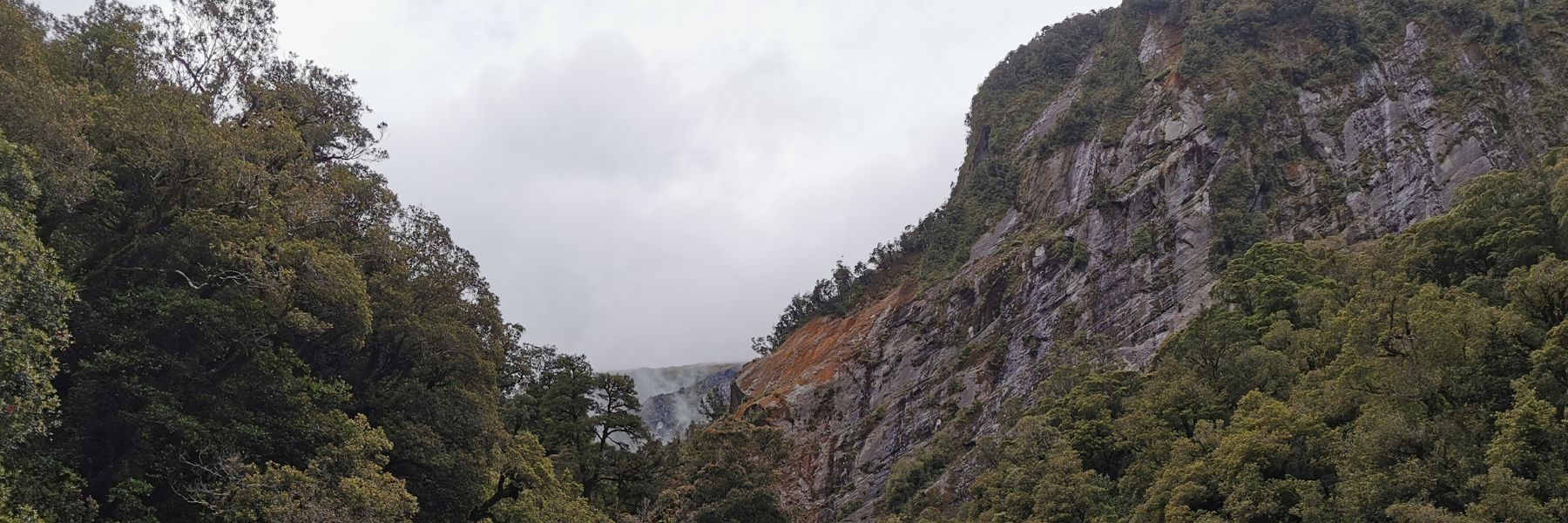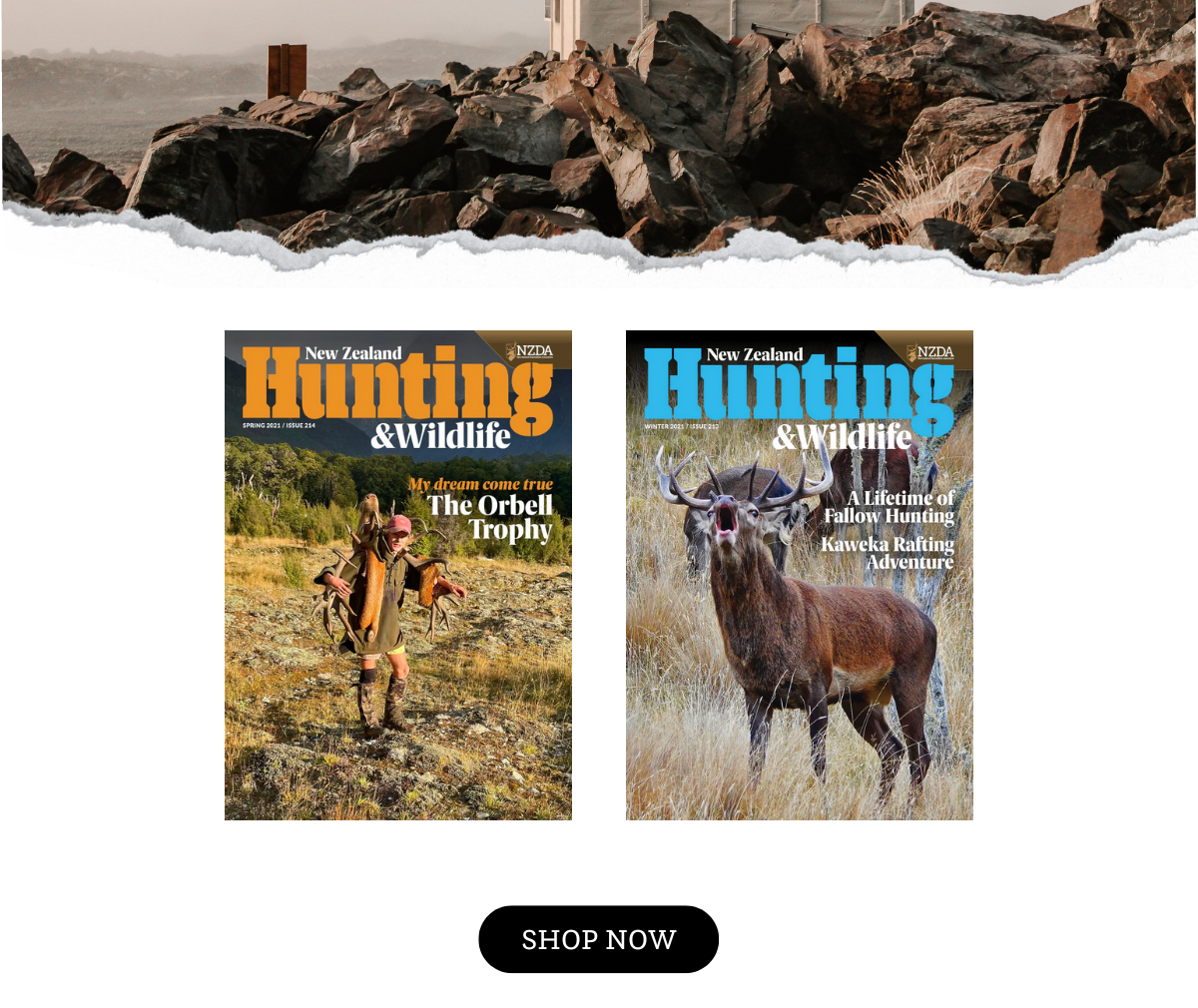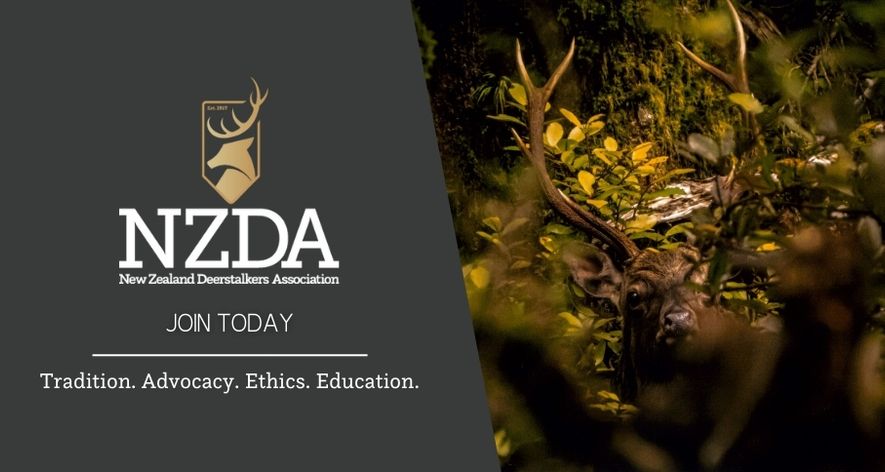Boulders, Bucks ‘N’ Bulls
27 August 2023
Hunting and Wildlife Magazine - Autumn Issue 220
Words By: Gwyn Thurlow
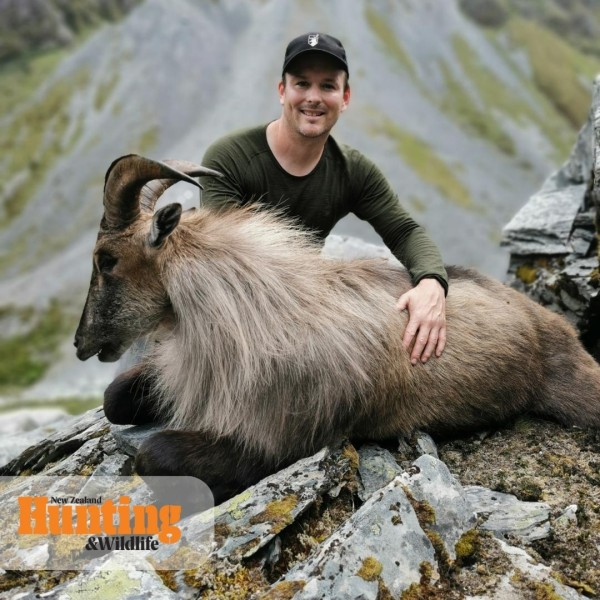
The author with his hard won bull. 13-inches and 10 years old.
Architect Creek is a tributary of the Copland River in South Westland. I’d never been there until an adventure over New Year’s 2021/22 when I spent a week hunting solo for chamois and tahr. For all my blood, sweat and tears, I dragged a 10-inch buck chamois and a 13-inch bull tahr out of that boulder strewn West Coast valley.
Architect Creek is a challenge to reach. It is for the determined because you cannot fly in, so it’s walk-in only. There is no cut track, so you have to find your own way through dense scrub.
Over the years I’ve heard rumors there’s a route and learned of stories about intrepid hunters who got in, hunted hard, and shot a good trophy head. That was my goal too and in the summer of ’21-22 everything aligned, and I had my own adventure.
As I departed the main river valley and bid farewell to the bright blue, glacier fed waters of the Copland River, I found myself following a deer trail – or was it a tahr trail. I paced uphill steadily while listening to the fast-flowing waters of Architect Creek gurgling far off. For a side creek it is a large body of water and if it was located in the North Island, it would certainly been classed as a river.
At this point, there’s no defined track and the terrain is rugged. It is strewn with huge house sized rocks with seemingly bottomless fissures to avoid and navigate. The terrain typifies the West Coast’s glacier valleys, with gaps between rocks which can easily swallow up a person (and has).
I’ll admit, the walk in was a frustrating grind. It is just plain hard work, especially with a week’s food, and all the gear necessary for safety, comfort and hunting, on your shoulders.
The thick nature of the bush meant I was constantly clambering under, over, and around objects – trees, bluffs, slips, log jams, and boulders. My rifle seemed to snag on everything too.
There was one point when I had to drop into the creek and leap between boulders with the fast-flowing Architect Creek waters rushing below by feet. No margin for error. It shook my nerves a little. I thought, “Is all this worth it?” “Can I get back?” “One slip and I’m under a log jam.”
I’d set off from the road end quite late in the day. The going was slow and tiring, so I didn’t make it far. I found a tenuous campsite under a rock overhang and leveled off a sleeping mat sized area. During the night it rained, and my rock overhang became a waterfall. The wet weather was forecast to move on and then clear for the entire week ahead, or so the forecast said, and so I hoped.
The next morning, I awoke to continued rain. I was busting for a pee so got dressed and checked the creek. It was up high but not a raging flood. It would go back down over the course of the day. I crawled back into my sleeping bag and waited for the weather to improve.
It is at this point I should mention I saw chamois and tahr on my way in, bumping into them in the bush. I was not in stalking mode, so I did not have a chance at a shot, but I did see a good bull tahr and some young chamois.
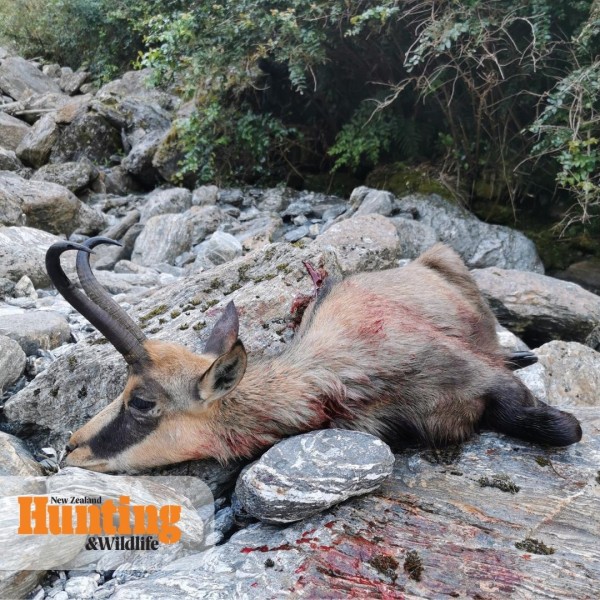
Trophy chamois can turn up in the most unexpected places and when you least expect to see one but in this case I secured a first rate trophy.
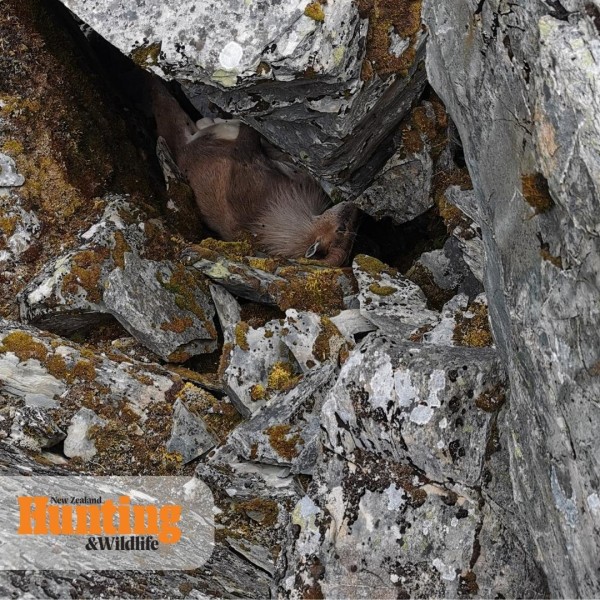
Even though there was a powerful smell of bull tahr where I’d last seen him, it was quite some-time before I found my trophy wedged under a big boulder.
Once the rain eased, I packed up.
That morning I moved, or should I say struggled, farther and farther up Architect Creek and hit some good-sized side creeks. If you have ever hunted the West Coast, you’ll know you can use these creeks as routes to gain elevation. It was when I was ascending a side creek that I encountered a magnificent buck chamois.
I’d just taken a break for lunch and decided to dry off a bit of gear in the sun. I was relaxing and sunning myself when I heard a noise. It was the kind of half-noise that a non-hunter would ignore, but it is the kind of noise that makes hunters instinctively reach for their rifle to make sure it’s close at hand, just in case.
I looked around and saw nothing, so went back to relaxing, drying out, and dozing in the sun’s rays. I soon got stiff and decided to keep moving but no sooner had I shouldered my pack and rifle and taken a few steps did I lock eyes with a chamois 50m up the creek.
I was standing on a relatively flat, open section but the chamois was in a steeper section with rock walls preventing a quick escape. We both panicked (I want to say the buck panicked a split second before me!).
I flung off my pack, after unslinging my rifle. As I did, the chamois bounced around the creek trying to flee. Each way it turned it was met by a rock. It eventually decided its escape route was downhill and past me. By this point, I could see impressively long hooks and registered it as a shooter.
I loaded a round into my 7mm Rem Mag Blaser R8 rifle and shot the buck off hand at full flight only 25 metres away. He dropped on impact from a solid hit to the lower neck just where it meets the shoulder.
I sat down and collected my thoughts after the intense adrenaline rush. The buck had a trophy head, and I was elated.
Not much happened over the coming days. I enjoyed blue bird days and whiled away time glassing, snacking, drinking coffee, and napping. I photographed keas and distant chamois and tahr. It was an enjoyable time spent in awe-inspiring surroundings.
Four days and nights after my chamois encounter, I spotted the first mature bull tahr worth a closer look.
It was the last hour or so before dark. I’d put the spotter on him at 8.32pm. The bull was 600 metres away in rough terrain. I kept glassing for other animals but watched the bull at intervals. He weaved his way through scrub and boulders, disappearing and re-appearing.
The bull eventually climbed onto a large car sized boulder that had another larger pyramid shaped rock as a backdrop. The rocks were grey, so his dark horns were clearly silhouetted. I put the spotter back on him and on second assessment thought to myself, “Damn, he’s probably an old bull with a large body and horns longer than I gave him credit for. Better take a closer look.”
The bull was unquestionably the best animal I had seen by a margin, so I closed the gap to 320m and found a clear area to set up my spotter. At first, I was a bit annoyed because I couldn’t relocate the bull.
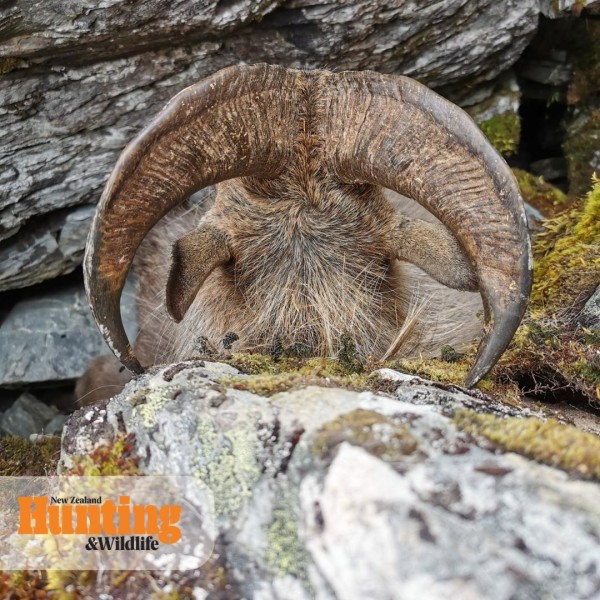
A mature tahr head when viewed from above has a heart shape.
Time was ticking and it wouldn’t be long before shooting light faded.
I then saw the bull’s rump. He was feeding partly obscured with his rear end visible. I took time to set up for a shot, should I decide he was a shooter. It was an awkward angle. I was on a downhill slope and needed to shoot over scrub.
After setting up, I went back to the spotter only to find that the bull was out of sight yet again. I used my binos to get a wider field of view. After a minute I spotted him by a flash of movement - he jumped from one rock to another. I adjusted the spotter and at that range, on 50x zoom, it was clear to see he had both age and length in his hooks.
I quickly got behind my rifle and dialed the scope for the range. I needed to get a steady rest and take a shot before he went out of sight again.
The bull was taking a break from moving through the boulder field and admiring his domain because he was standing head up and looking down valley. I wanted to maximise my target and minimize my margin of error, so I waited for him to extend his head forward.
In the fading light, I finally squeezed the trigger and sent a 150gr projectile at 2975 fps towards the bull’s shoulder. On the shot I lost sight of him due to the recoil of my magnum, but I heard the unmistakable sound of a solid hit echo back at me, “thwack.”
It would be dark soon and there was no chance of a recovery. I packed up and made it to camp by the aid of my head torch.
I went to bed that night wondering if I would find the bull in the jumble of boulders and scrub. I tossed and turned, thinking, “Would he run? Would there be a blood trail? Would he be as good a trophy as I thought?”
The next morning, I was up at sunrise. I got to the location I’d taken the shot from and made a mental note of the boulder layout, knowing it would appear different once I got to the bull’s last known position.
It ended up taking me a good hour to reach the pyramid shaped boulder. A distinctive marker. I dropped my pack and rifle, so I could move and clamber about more easily.
I searched high and low. I didn’t find any blood; however, I could smell the scent of bull tahr filling my nostrils.
I went over the same area a couple of times without finding him. Before getting too frustrated, I decided to have a break and brew a coffee.
When I resumed my search, I was sure I was on top of him or thereabouts. I clambered up a rock and peered over the side. I noticed some strands of hair. I got onto my hands and knees, inched out, and craned my neck. Low and behold there he was wedged down a crack in some boulders. I’d found him.
I spent the next while hauling the hulking beast out of his resting spot. It was a decent struggle to wrestle him out. Eventually, I lay puffing next to him. He was big bodied.
I aged him at 10. I’d secured another trophy head for my efforts. I slept easy that night.
It was a memorable adventure but on reflection Architect Creek is the kind of spot you might only visit once – it is one brutal journey to navigate and the hunting isn’t that easy, but it will leave a lasting memory on anyone who does take on its boulders.
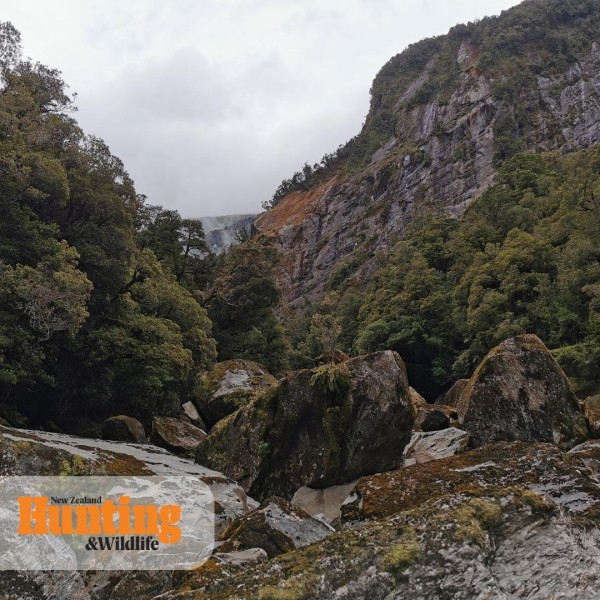
Architect Creek will leave a lasting memory on anyone who takes on its boulders.

